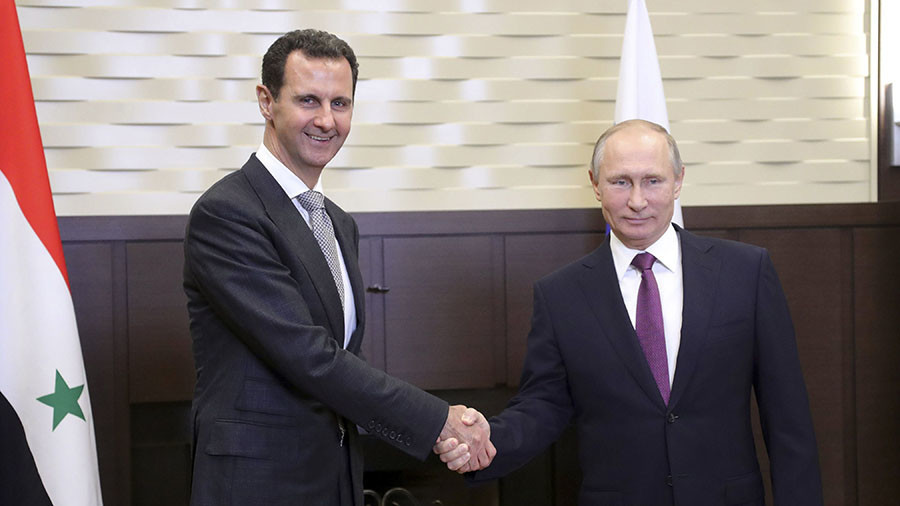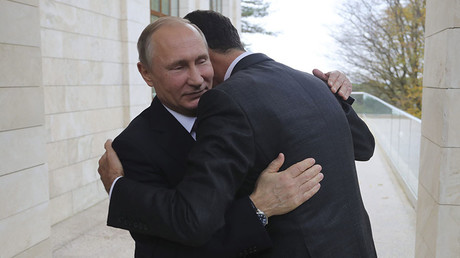Syria, Russia & Iran shift to diplomacy, while US and allies push for war
Finian Cunningham (born 1963) has written extensively on international affairs, with articles published in several languages. Originally from Belfast, Ireland, he is a Master’s graduate in Agricultural Chemistry and worked as a scientific editor for the Royal Society of Chemistry, Cambridge, England, before pursuing a career in newspaper journalism. For over 20 years he worked as an editor and writer in major news media organizations, including The Mirror, Irish Times and Independent. Now a freelance journalist based in East Africa, his columns appear on RT, Sputnik, Strategic Culture Foundation and Press TV.

In a big week for Syrian peace talks, President Assad was hosted by Russian President Vladimir Putin in Sochi, where the leaders of Iran and Turkey are also to convene. Fittingly, perhaps, the US had no input into the renewed effort for peace in Syria.
Putin said that with the defeat of ISIS (Daesh, Islamic State) and other terror groups in Syria now virtually achieved, the parties to the conflict must underpin the political means to win the peace. Significantly, the talks in the Russian Black Sea resort of Sochi reinforce the earlier Geneva accord which assents to President Bashar Assad and his government in Damascus as the sovereign authority of Syria.
The demand by Washington and its European allies for Assad to “stand down” has long ago expired. That void is a tacit acknowledgment the nearly seven-year covert war in Syria for regime change has been defeated or at least the covert war in its guise of Western-backed proxy militant groups.
The absence of US and European officials at the peace talks in Sochi this week speaks volumes about their pernicious role in the Syrian war.
While Syria, Russia, Iran, and Turkey endeavor to revamp the peace negotiations, it is significant that Pentagon chief James Mattis was last week saying that US military forces would be digging in further on Syrian territory.
The reluctance of US forces to pack up in Syria despite the demise of the terror groups is perhaps best viewed as part of a regional resurgence of an American military presence. Under President Trump – despite his election campaign promises – the level of US forces has increased substantially in Afghanistan and Iraq. Deployment in Syria fits into this pattern of a regional buildup.
The increasing level of US military strength in the region also underlines the ominous signs of Saudi Arabia and Israel ramping up hostility toward Iran and Lebanon.
Last week, US Defense Secretary James Mattis said American forces would be staying in Syria despite the contradiction of terror groups being routed. Mattis' claims that US forces have a legal United Nations’ mandate for their presence in Syria were dismissed by Russia and Syria as a flawed understanding of international law.
But even on Mattis’ own faulty reasoning, his claims are dubious. If US forces have a mandate to be in Syria to defeat terrorists, as claimed, then why are they there given the terrorists have been largely defeated?
Mattis said the new purpose of US forces were to “prevent ISIS 2.0” arising. Despite the fact that the Americans hardly ever engaged in fighting against ISIS, and indeed, as the BBC even reported, gave the militants safe passage, including helicopter airlifting commanders out of harm’s way.
It was the Syrian Arab Army, Russia, Iran and Hezbollah who did all the heavy lifting to roll back the terror groups, which had been covertly armed and financed by the US and its NATO and regional client regimes. ISIS, Nusra, and all the other alphabet-soup terror groups were only ever a pretext for the US to deploy its warplanes and Special Forces in Syria – a presence which actually constitutes foreign aggression, as the Syrian government and Russia have repeatedly pointed out.
And yet here we have Mattis claiming that it was the US which defeated ISIS in Syria, and warning that the specter of this American asset reemerging as ISIS 2.0 is grounds for continuing to occupy Syrian territory. The Americans’ handy phantom-enemy is serving twice over. That is to “legitimize” the US intervening in Syria; and now to justify US forces staying there – just when the real victors against the terrorists, Syria, Russia, and Iran are trying to demilitarize the country.
Far from the public view, US forces are scaling up their presence in Syria, Afghanistan, and Iraq. Politico has called it an “official charade.” The Trump administration and the Pentagon are going behind the American people’s backs to deploy thousands more troops across the Middle East.
Much to the displeasure of Washington, Turkey disclosed last week that the US has 13 military bases in Syria. Russia, apparently, has only five bases, even though that country had a much greater military impact on defeating ISIS and other terrorist networks over the past two years.
One of the biggest US bases is near Kobani, about 140 kilometers from the northern city of Raqqa. This is the location no doubt where Mattis was referring to when he said last week that US forces would be digging in.
The US airbase at Kobani has been dramatically upgraded over the past year from what was a rough airfield accommodating only a select few types of aircraft to one now where “every type of air frame” in the Pentagon’s fleet can be landed, including the largest troop-carrying and cargo planes.
The US base at Kobani is also part of a chain of new airfields that connect from Qayarrah West in northern Iraq, to the Taqba Dam, also north of Raqqa.
Officially, there are supposed to be only 500 troops in Syria under the Pentagon’s Force Management Level policy. But as with Afghanistan and Iraq, the real numbers are believed to be much higher than what is officially acknowledged.
A large part of the false accounting arises because the Pentagon doesn’t count units which spend less than 120 days in the country. These units include engineers and troops who are charged with building bridges, roads, and landing strips.
There is a direct analogy here with how US and NATO forces underestimate force levels in the Baltic and Black Sea regions by arbitrarily not counting troops, warplanes and ships described as “rotating presence.” But if you rotate frequently enough, the force levels in effect become permanent and are much larger in practice than is officially admitted.
In addition to ensuring its proxies don’t come back as “ISIS 2.0” (how’s that for chutzpah!), Mattis also said that the expanded US forces were there to ensure the future peace talks in Geneva, resuming on November 28, would gain “traction.”
“We’re not just going to walk away right now before the Geneva process has traction,” said Mattis last week while in London meeting his British counterparts.
What this suggests is that Washington is using its illegitimate military occupation of Syrian territory as a way to leverage the political process. By forcibly holding on to Syrian territory, Washington is perhaps calculating that the Assad government might cede to its demands on standing down or allowing a defeated opposition more say in drawing up a new constitution.
If the US were genuinely committed to a political process in Syria, then why aren’t its diplomats giving momentum to the Russian-brokered talks in Sochi this week in preparation for the subsequent Geneva summit?
But even more sinister is the region-wide context of US force buildup – largely in secret unknown to the American public. With Washington’s client regimes, Saudi Arabia and Israel, pushing for a confrontation with Iran, directly or via Lebanon and Yemen, the expanding military presence in Syria indicates war in that country is far from over. Instead, it could be but a prelude to a more devastating regional conflagration.
The statements, views and opinions expressed in this column are solely those of the author and do not necessarily represent those of RT.




0 Comments:
Post a Comment
Subscribe to Post Comments [Atom]
<< Home